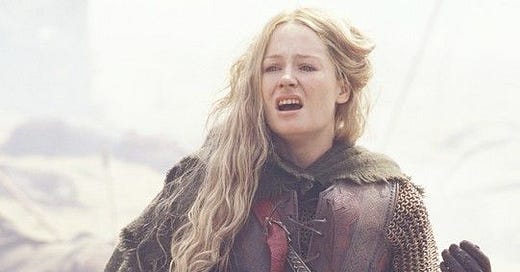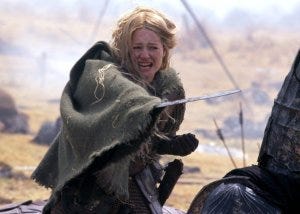This lecturette was another in that 2004 online course in DU’s professional writing Masters degree program, called Hobbits & Heroes. This week, the students would have progressed through Two Towers, from related intro materials, through The Hobbit and Fellowship. Any discussion board prompts you find here, feel free to respond to in the comments. Remember, too, that these were written for a class in 2004, and so may have a different flavor than other pieces here. I have not adapted them a whole lot, but may have added some notes from the future me (present me?), to fill in details or prompt reflection on the difference between how we looked at LOTR then vs. now, with all the new pop culture surrounding it. Enjoy! Forth Eorlingas!
Eowyn Heroine
2004 Hobbits & Heroes
Generally, in the myths and legends we hear as young girls, we’re given Sleeping Beauty, we’re given Cinderella. They’re all stories about women who are in difficult situations and are then saved by men. But Eowyn is a character who is in a difficult situation and must become empowered or lose everything. She knows she must find the strength within to save herself and her people.
–Miranda Otto, who played Eowyn in the film trilogy
Can you name all the female characters in LoTR? Let’s see: there’s Arwen Undomiel (the Evenstar and Aragorn’s love interest), Galadriel (Queen of the Wood of Lothlorien), Eowyn of the Edoras (King Theoden of Rohan’s niece). Who else? Um, Shelob? Does she count? Oh yeah, Goldberry. And a couple Elvish chicks in some songs sung by other characters (Luthien and Nimrodel). Okay, so we’re talking books not films, so again let’s see:
What do we know about Goldberry?
She’s the “river-daughter,” whatever that means. She’s Tom Bombadil’s wife and she keeps a peaceful, healthful house in the middle of the Old Forest. Her voice is almost magically beautiful: her singing has a way of making everything all right, and her great beauty inspires awe in the hobbits who meet her. An educated guess would place her as a water-nymph of some kind who is a fit partner for the elusive and powerful (and incredibly cheerful) Tom Bombadil.
What do we know about Arwen?
She’s the daughter of mighty Elrond Half-Elven, also granddaughter to Galadriel of Lorien. Here’s her description, from Fellowship:
…there sat a lady fair to look upon, and so like was she in form of womanhood to Elrond that Frodo guessed that she was one of his close kindred. Young she was and yet not so. The braids of her dark hair were touched by no frost; her white arms and clear face were flawless and smooth, and the light of stars was in her bright eyes, grey as a cloudless night; yet queenly she looked, and thought and knowledge were in her glance, as of one who has known many things that the years bring. Above her brow her head was covered with a cap of silver lace netted with small gems, glittering white; but her soft grey raiment had no ornament save a girdle of leaves wrought in silver.
And so we have one of the most detailed physical descriptions in the trilogy, and that’s all we get of Arwen until the end of the series (which isn’t covered in this week’s book so I won’t go into it in detail), wherein she gives Frodo a gift, reminiscent of Galadriel’s gifts in Fellowship. That’s it—she’s beautiful and an Elf. I’m not counting the story details in the Appendices, by the way—I’m sticking to the main LOTR story-arc of the books only. And, side note: if you’re wondering where I get my penchant for really long sentences, just go ahead and read the above excerpt again. Sigh…
What do we know about Galadriel?
She is a wise queen, and a Ring-Bearer, who resists the temptation of the Ring with flying colors, and has a magic pool. She shows great spiritual and Elvish power (we hear from her song that she raised Lorien’s mallorn trees with her singing), and impresses all, especially Gimli, with her queenly presence.
(NOTE: This class was held barely after the original Jackson film trilogy was released in theatres, and as such was obviously way before the current TV series, in which Galadriel is a younger, more warriorlike character and a major player in that prequel story. I haven’t seen this series myself—what do you think?)
Shelob?
Big. Evil. Spider. ‘Nuff said? I think so, until next week’s lecture on Corruption and Evil… At any rate, I categorize Shelob as a monster, not a woman. She’s said to be female, but I think it’s mainly because she’s a spider. Anyway I’m not counting her.
MODERN DAY AUTHOR ADDITION: But. Having said that? For more interesting discussion on Monstrous Women, checkout the Witch, Please podcast ep on the topic. I did find that interesting. I just don’t think Shelob (or her even more evil mom, Ungoliant) belongs on this list. Don’t agree? Argue with me in the comments.
And Now We Come to Eowyn:
No offense to the previous Great Ladies just mentioned, but Eowyn is really the only woman in the whole story who, well, does anything! Now hold on, don’t get me wrong—I’m not claiming she’s the only powerful woman in the tale (Galadriel is one of the wisest, most powerful beings in Middle-earth), but she’s the only female action-hero we’ve got. The Fellowship of the Nine Walkers are all heroes, in one way or another, even the meek hobbits (perhaps especially them), but never before we meet Eowyn do the women characters do anything but stay in their home and dispense wisdom, care, and gifts to our travelers on their journey. They don’t journey or fight, themselves. They’re homebound healers at best, prizes to be won at worst.
Eowyn even is relegated to this status when we first meet her: Hama suggests and Theoden approves her staying behind, because “she is fearless and high-hearted. All love her. Let her be as lord to the Eorlingas, while we are gone.” We can tell she is not happy with this choice, but later in RoTK, when the men are riding off to what will most likely be their last battle, she responds to Aragorn’s request that she stay behind:
“All your words are but to say: you are a woman, and your part is in the house. But when the men have died in battle and honour, you have leave to be burned in the house, for the men will need it no more. But I am of the House of Eorl and not a serving-woman. I can ride and wield blade, and I do not fear either pain or death.”
We first meet Eowyn in Two Towers, then her great deed of heroism comes in the next book, during one of the biggest battle scenes in the series. In our discussions, I’d like to hear your impressions of Eowyn as a female character compared to the others you’ve seen so far. If you’ve already gotten pretty far in Return of the King, or don’t mind having a surprise told to you before you read it, you can respond to the following as well:
SPOILER ALERT:
There have been many who argue that Eowyn is no heroine, but a deserter, abandoning her ordered duty, riding into battle for purely selfish reasons. Also that her killing of the Witch-King is really Merry’s kill (he’s no man either technically, but a hobbit). I’ve linked another discussion board on our Nine Rings page—read as much of it as you like, and I’d like to hear what you think of the whole thing.* A good thing to do first is formulate your criteria for what makes a hero.
*Sorry current readers: I have no idea what this would have been. I assume it was an ancient online chat forum (remember those?) on the movies vs. books—plenty of those popped up once the Jackson blockbusters came out.
MORE STUFF FROM TODAY’S ME: Okay, so… yeah this is like one of the most tautly hot flirting scenes in certainly all action cinema, right? I do appreciate the way that the (relatively) modern filmmakers were able to expand the role of women in this epic story, and how they continue to do so. I do have some major issues story-wise and pacing-wise with how they re-vamped Arwen in the movies, but I appreciate what they were trying to do. And this Eowyn did a great job. I mean, look.
Oh, also? As an expert in theatrical fighty bits? What do I think? Yeah, it’s pretty good.




